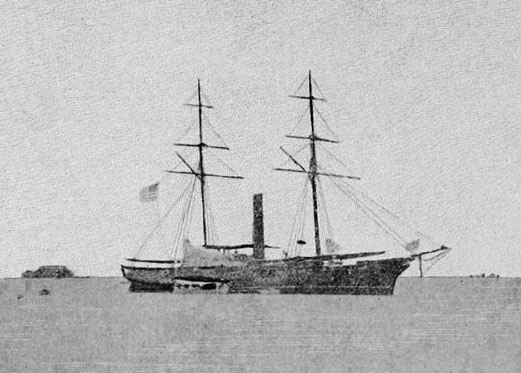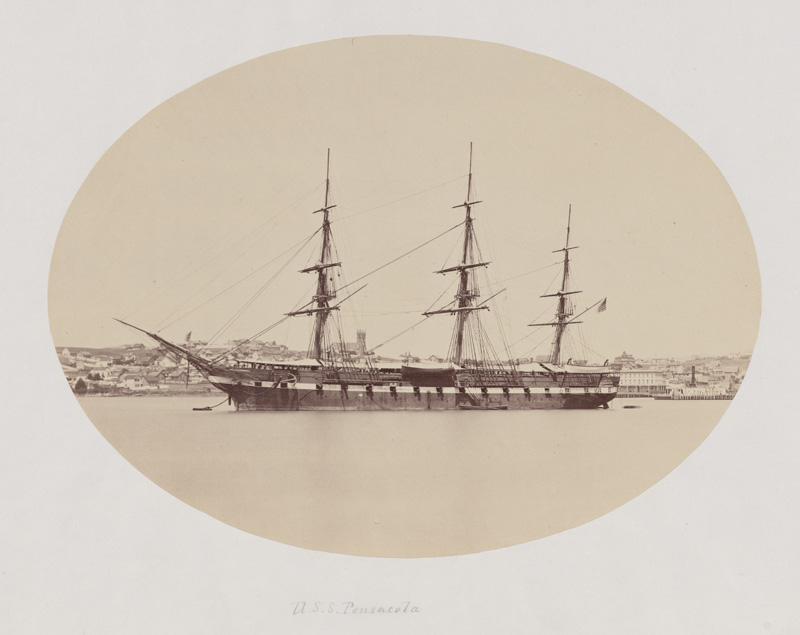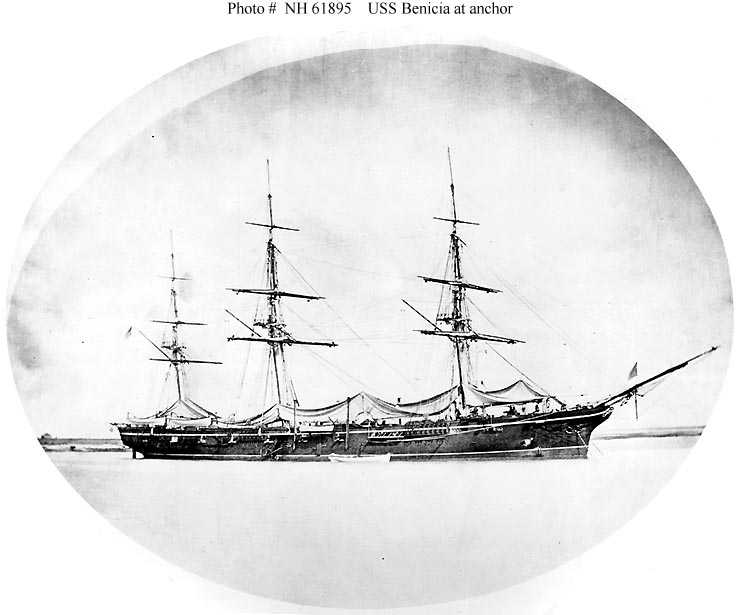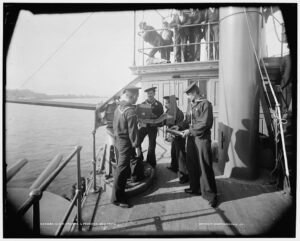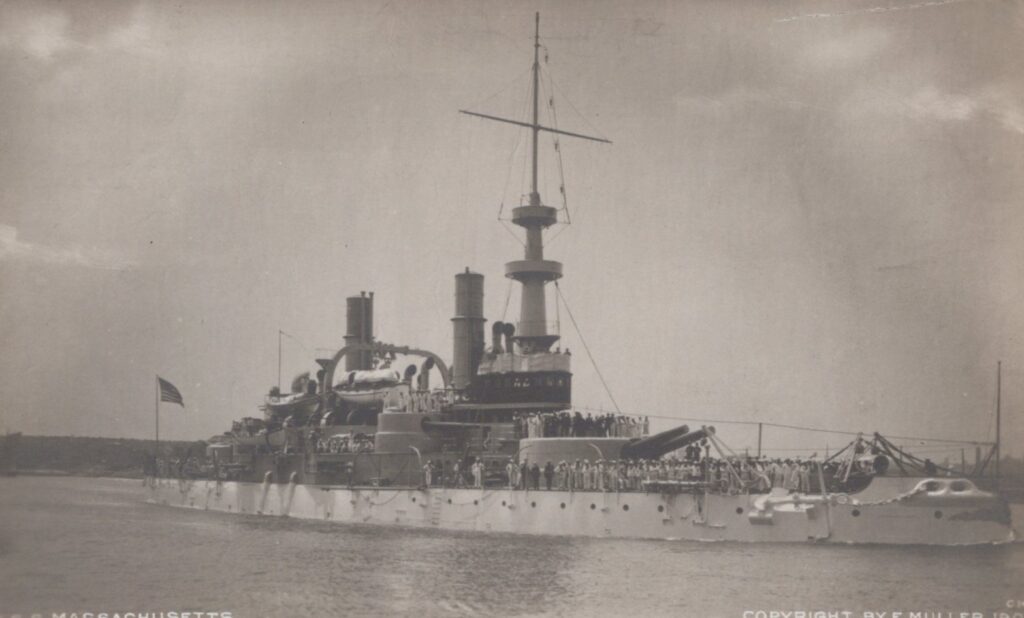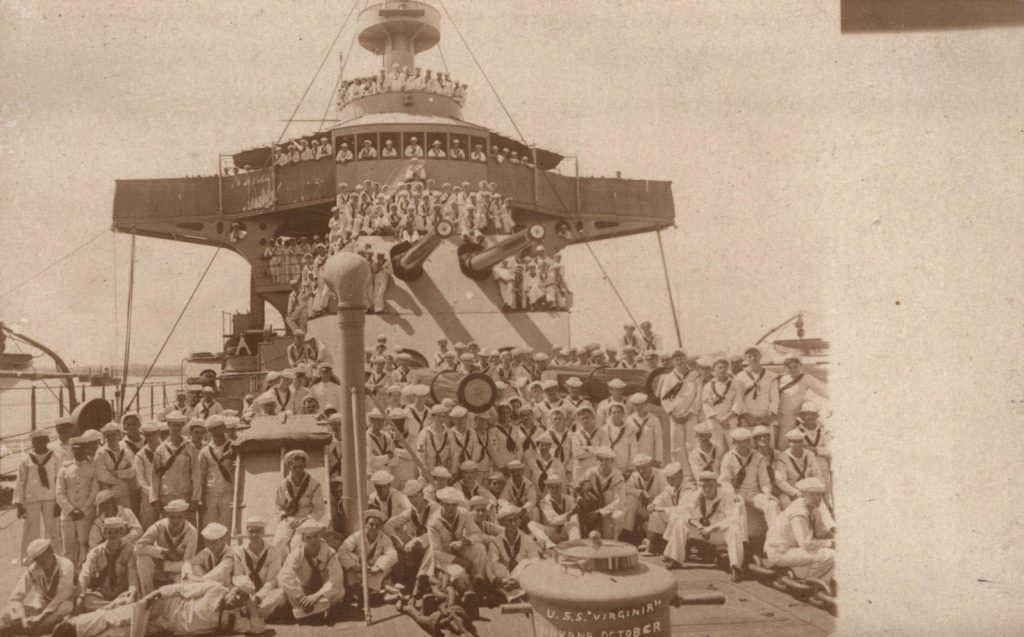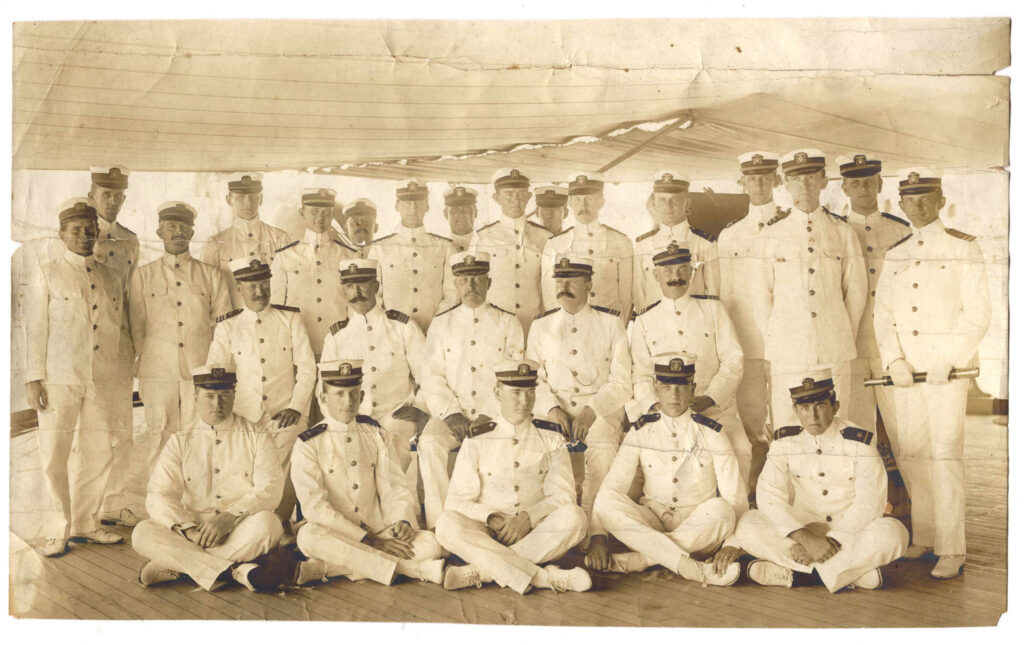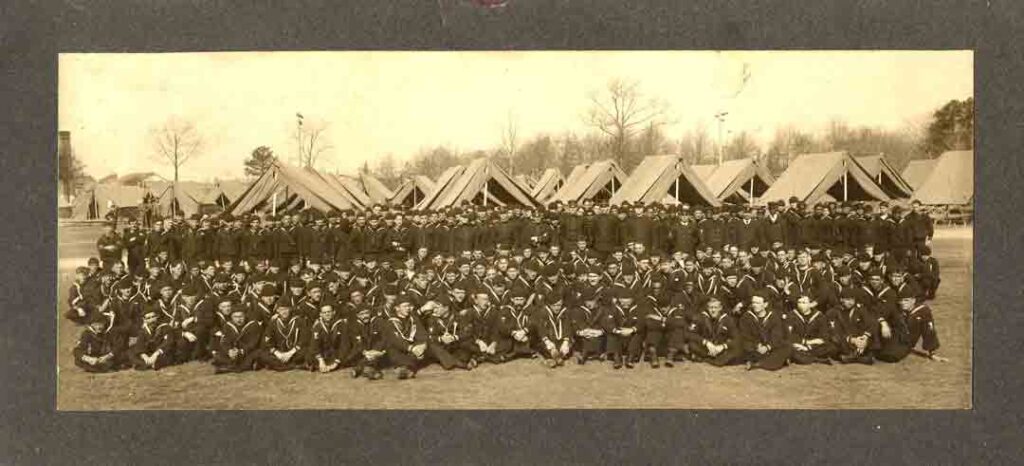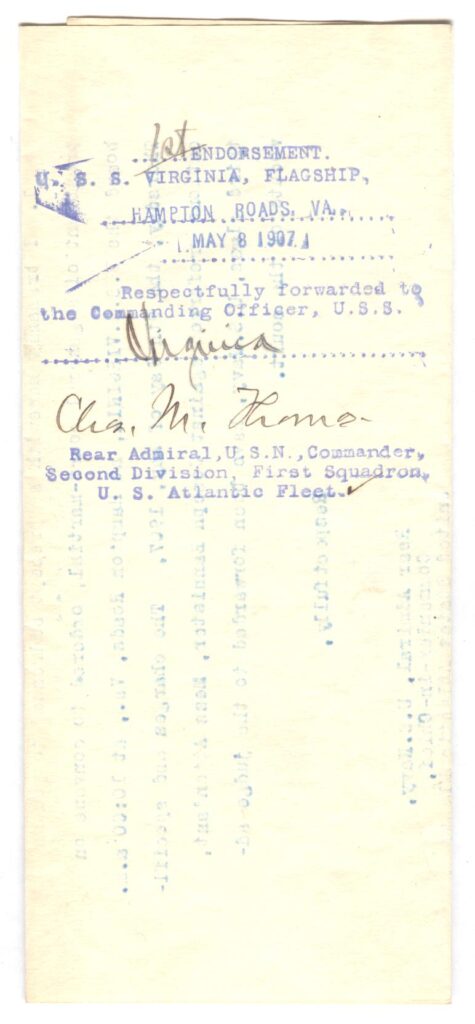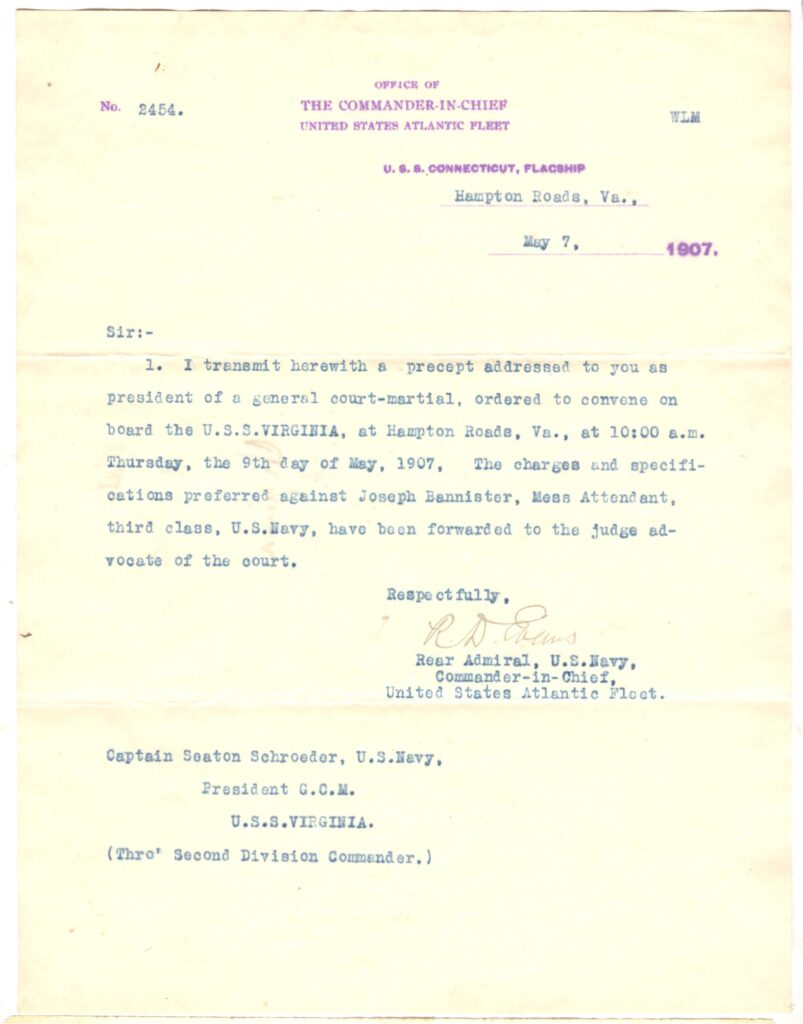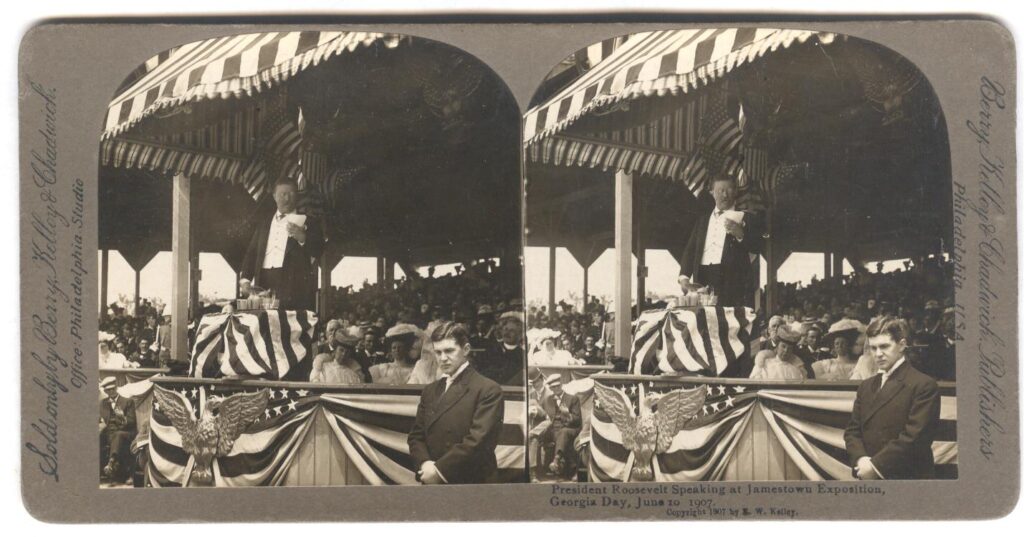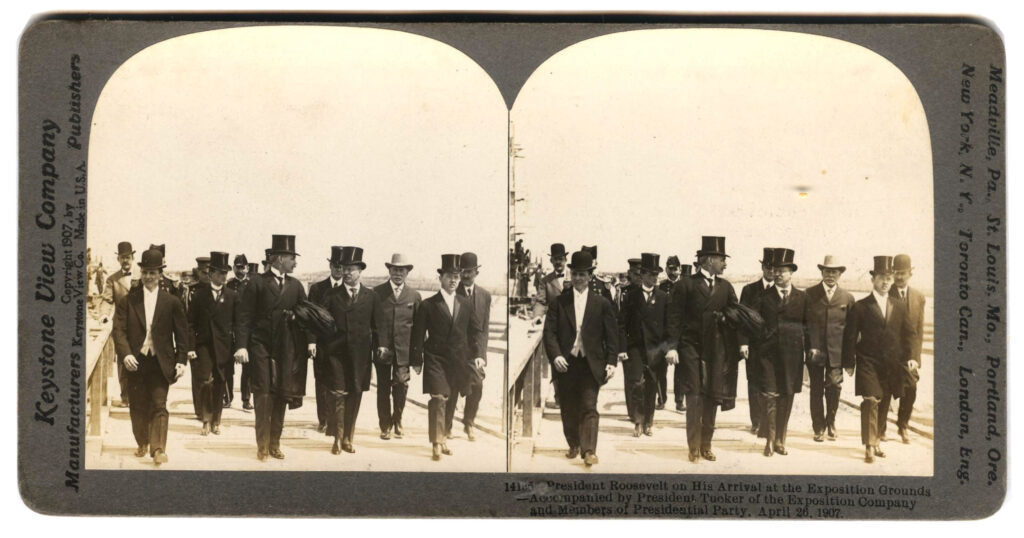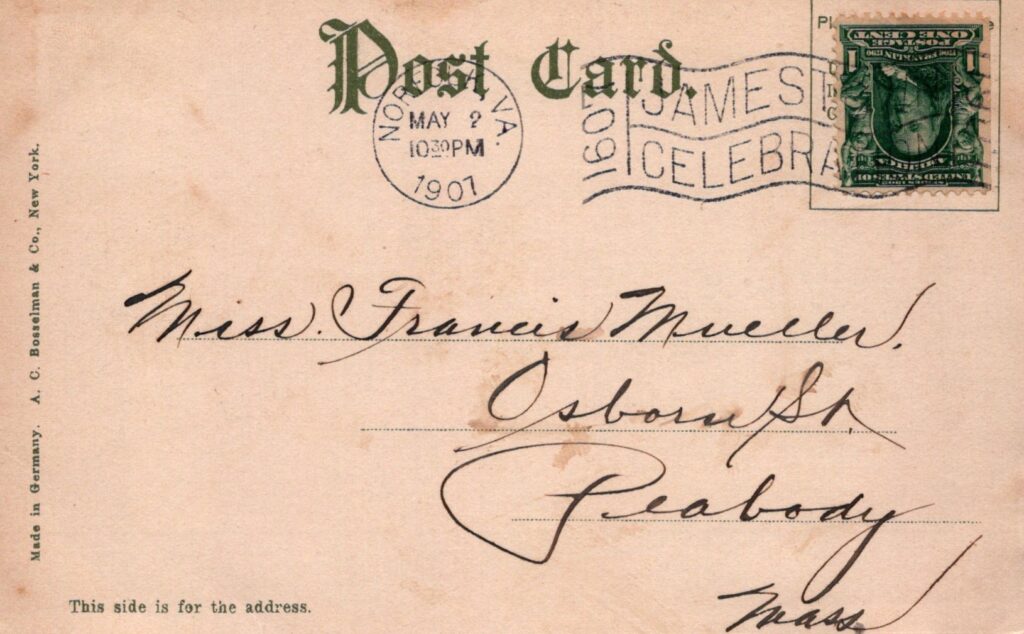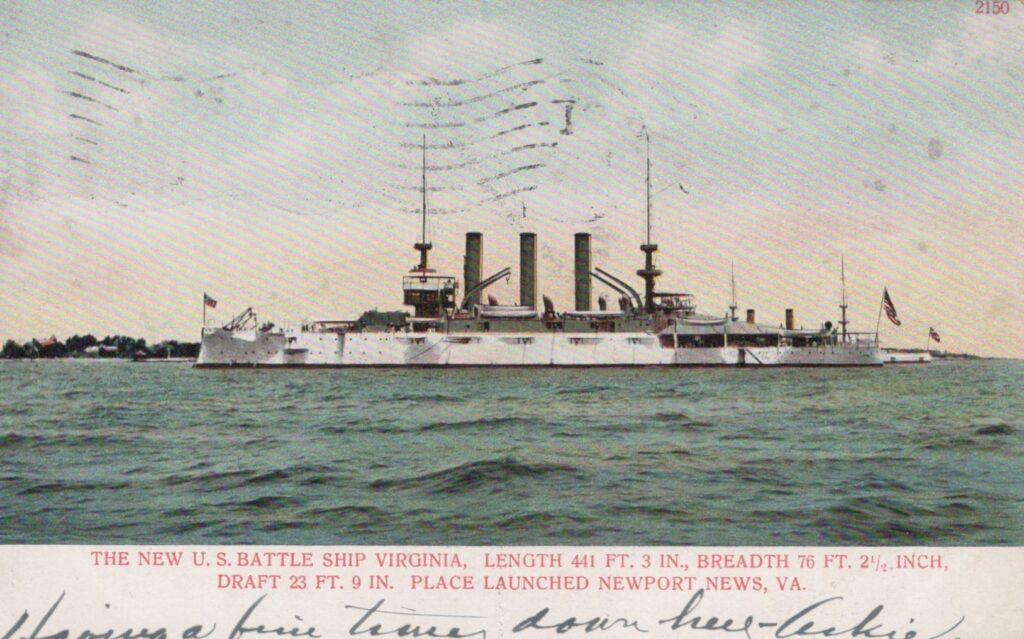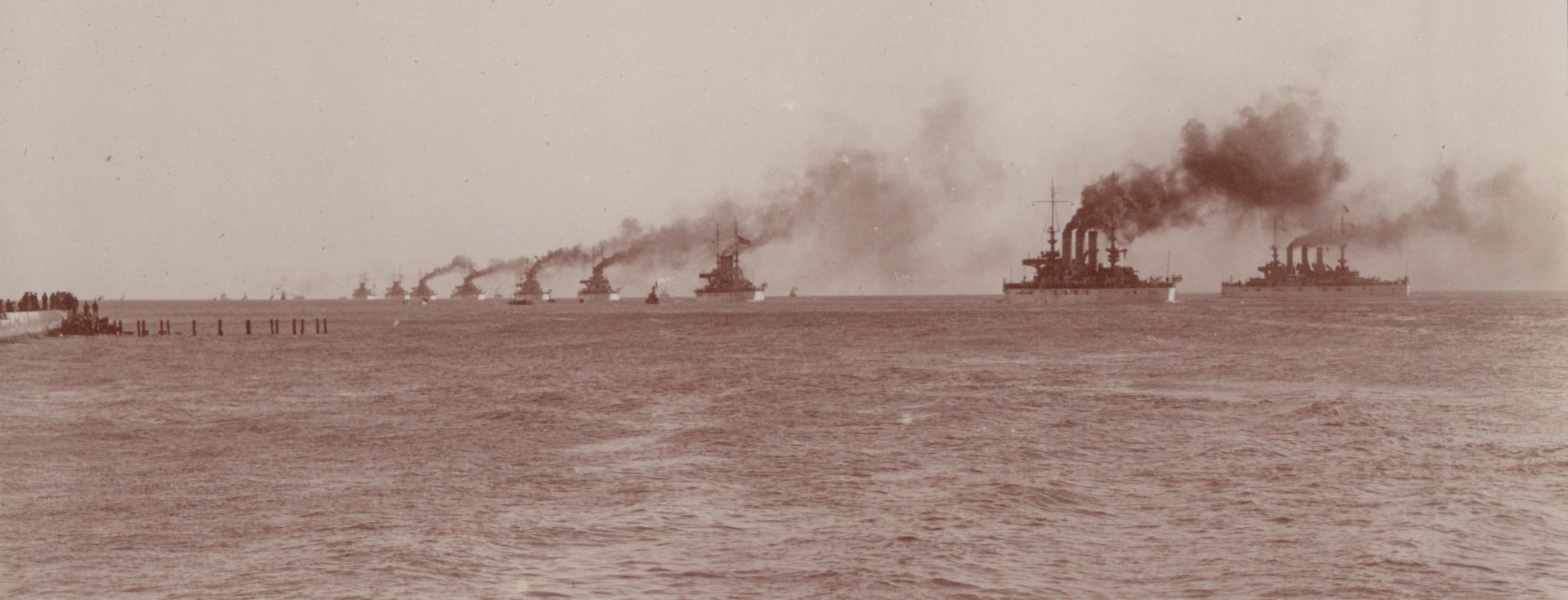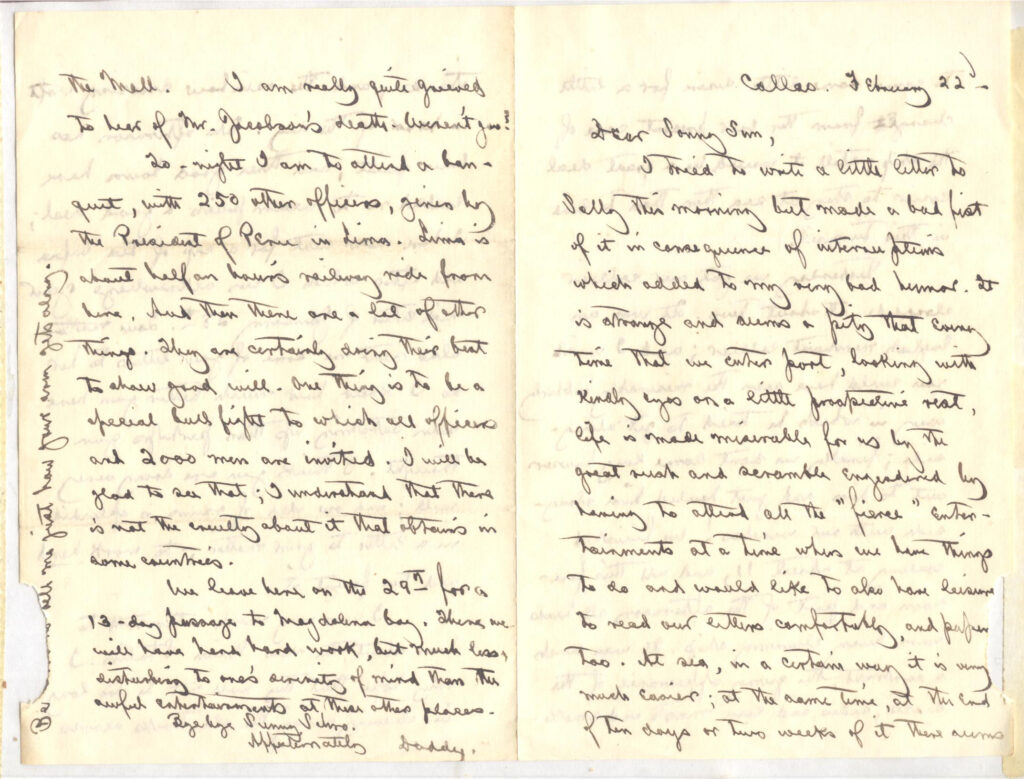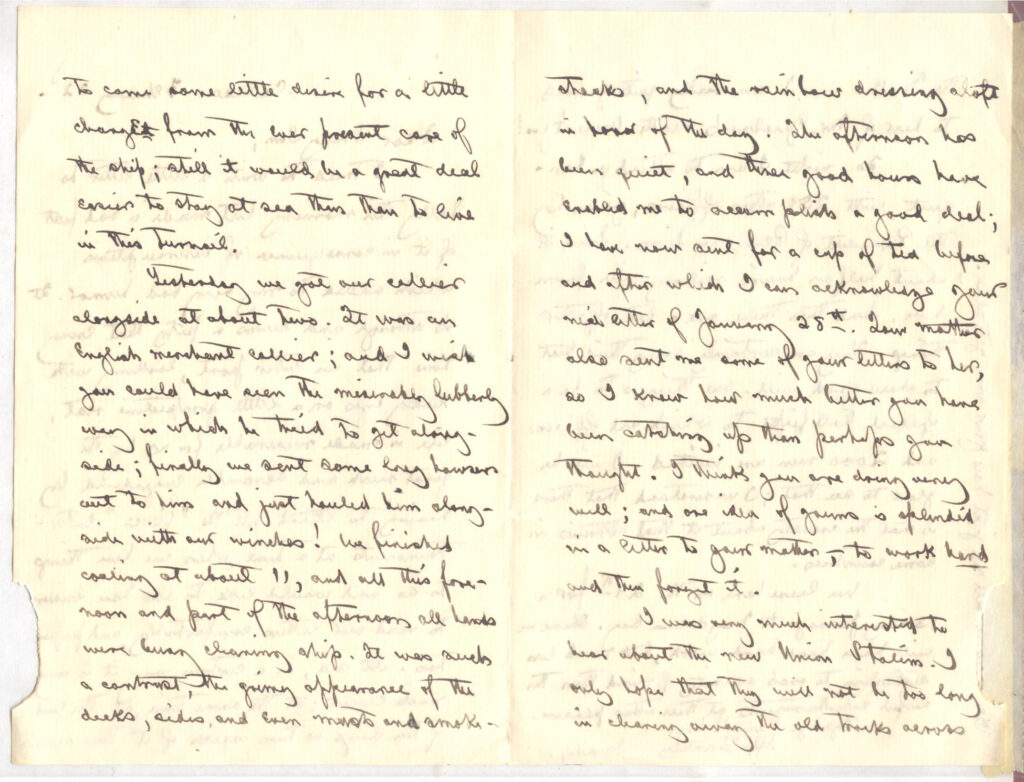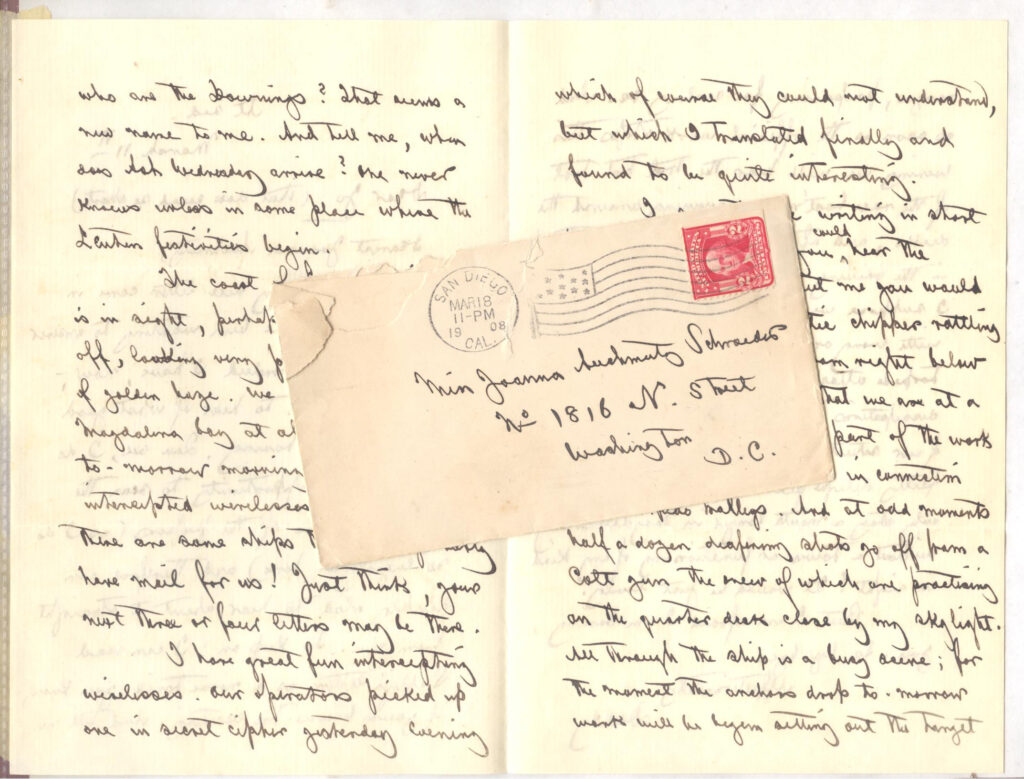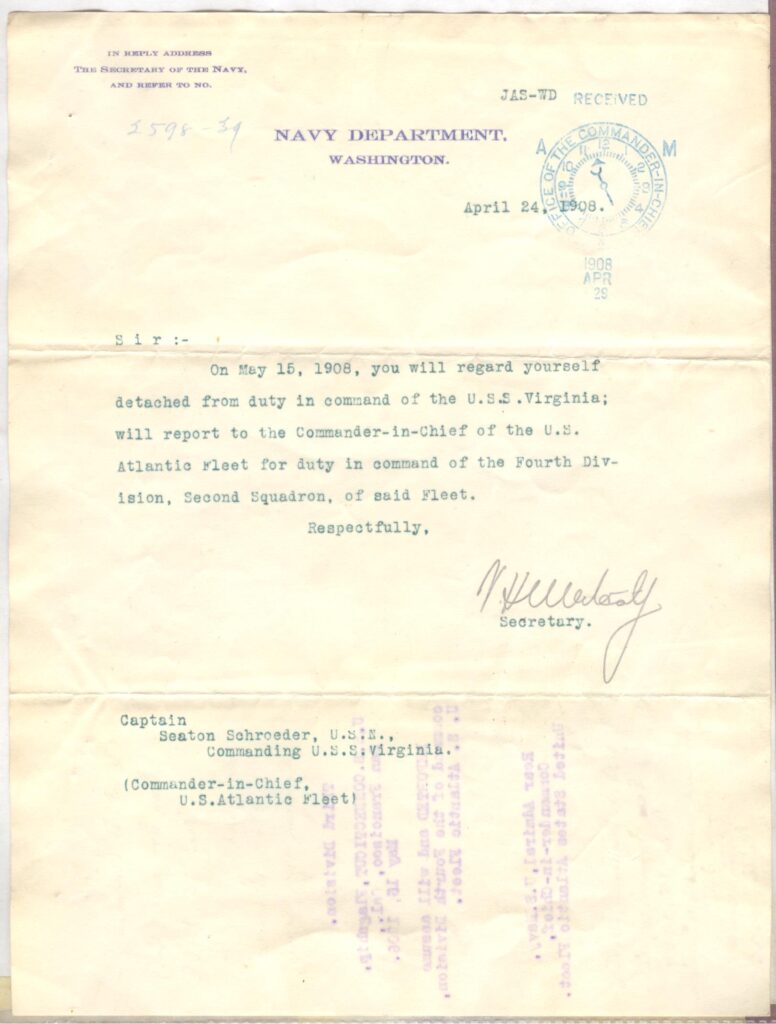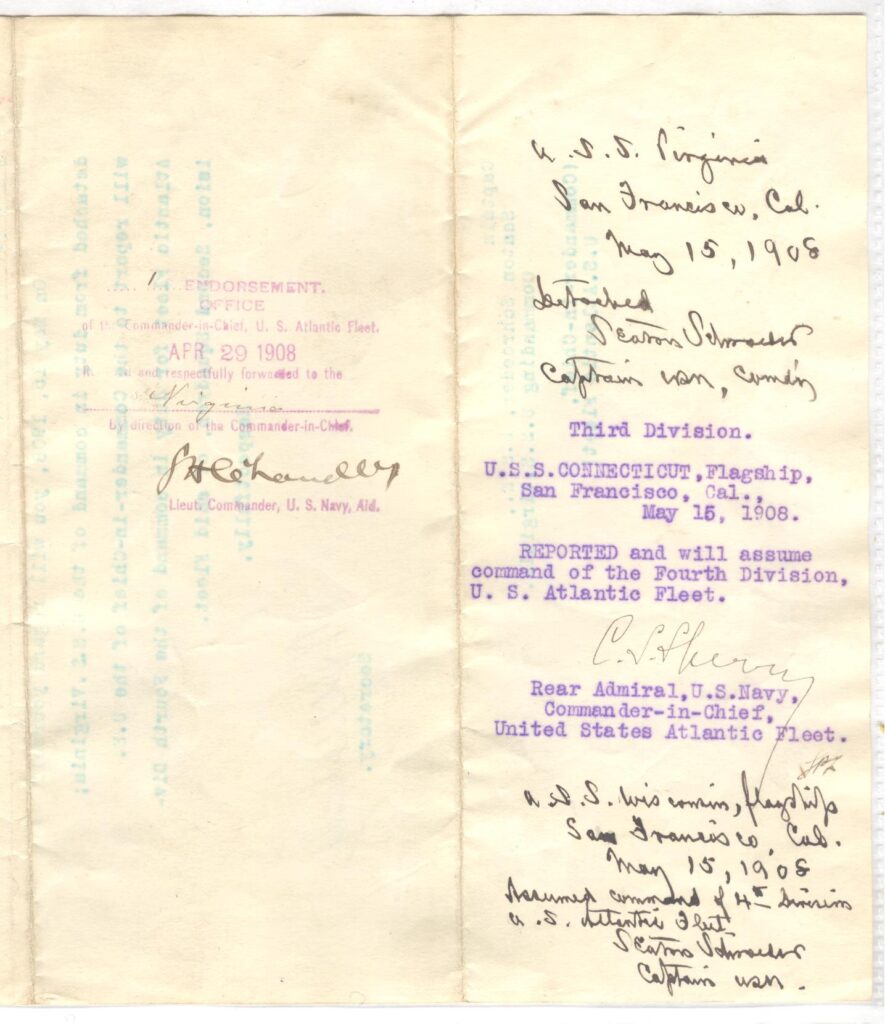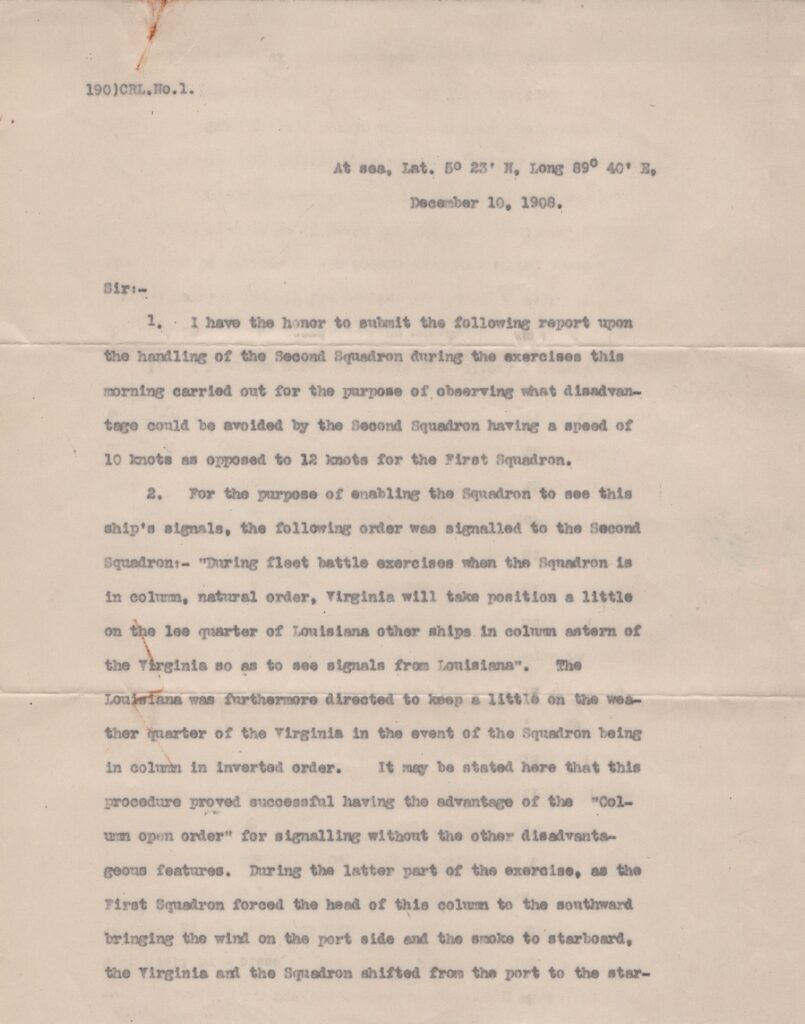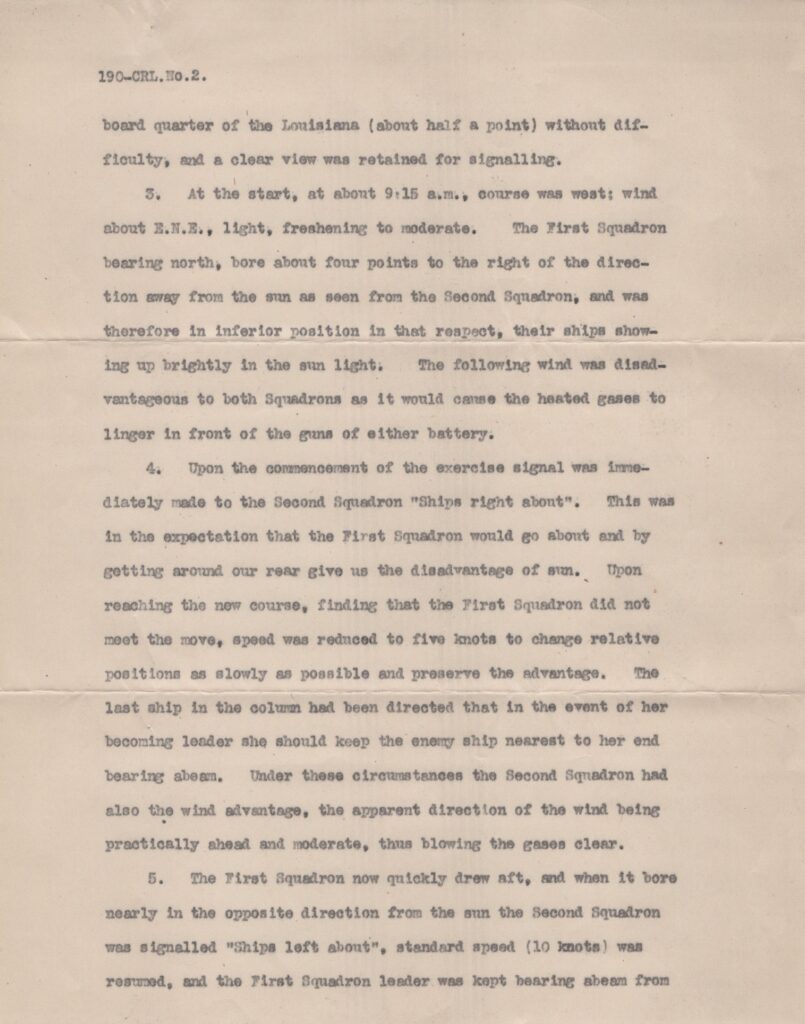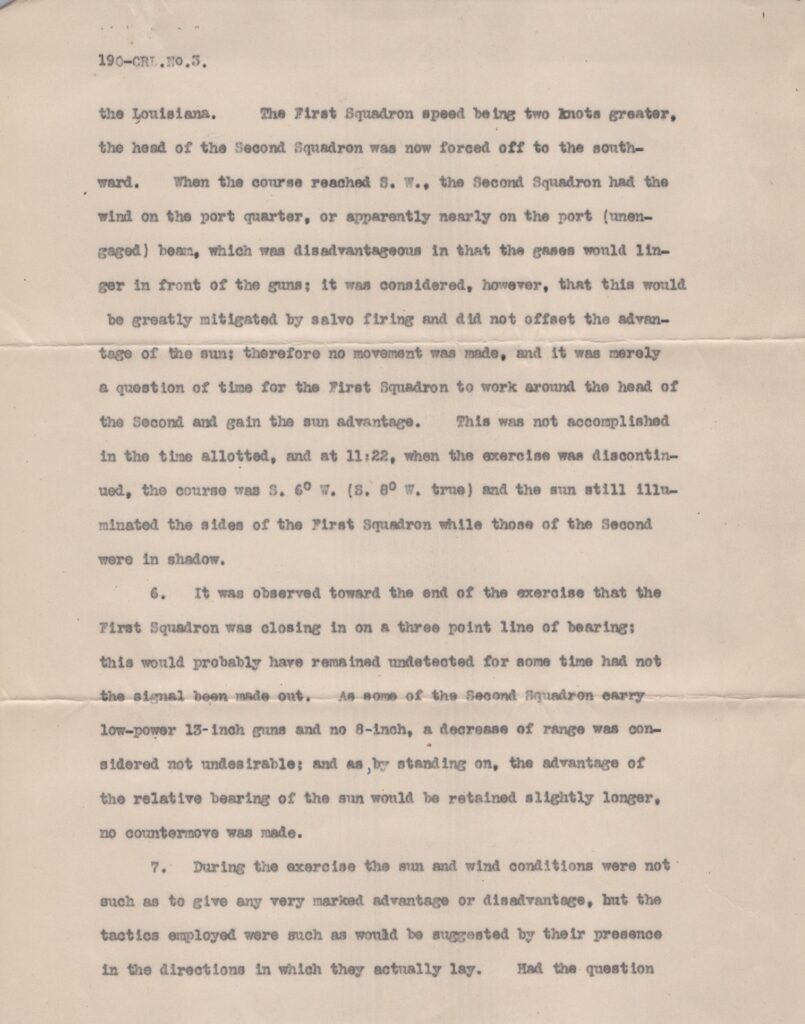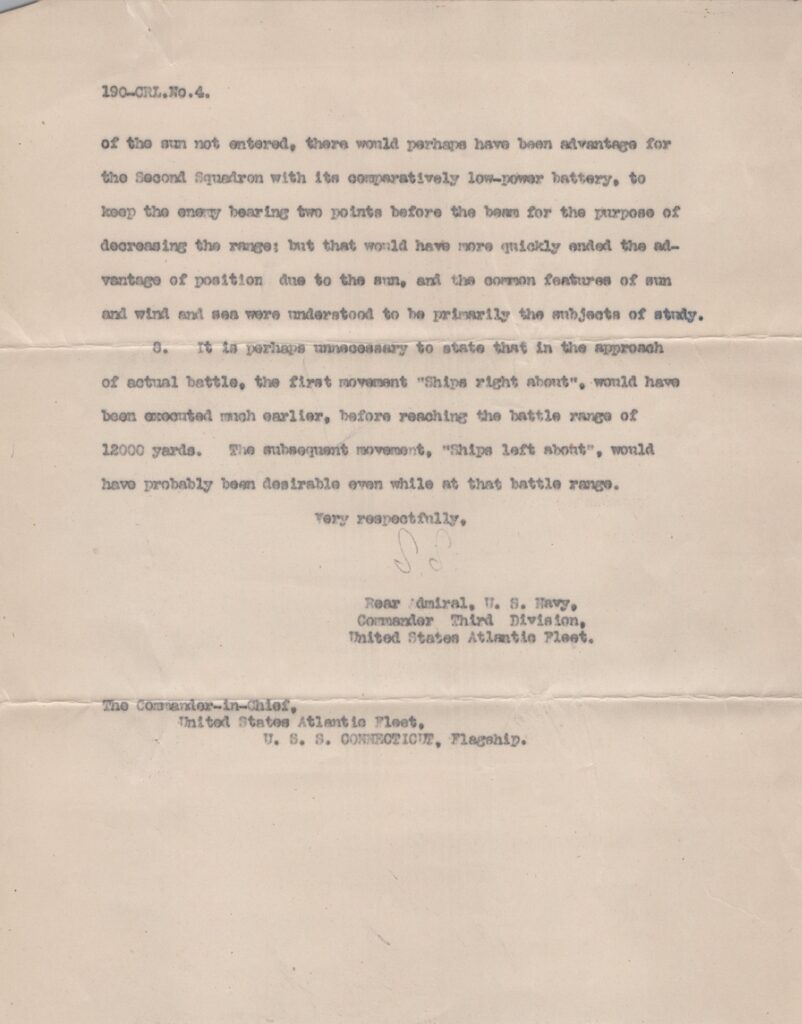Apologies, but no results were found for the requested archive. Perhaps searching will help find a related post.
On May 15, 1908 Captain Seaton Schroeder, Commanding Officer, USS Virginia, on board the flagship Connecticut assumed command of Fourth Division. He was in the Naval Academy graduating class of 1868 and served the Navy and his Country for over 50 years.
related sections
- Commander-in-Chief , Theodore Roosevelt
- CIC, Atlantic Fleet, Robley D. Evans (first leg)
- CIC, Atlantic Fleet, Charles M. Thomas (interum)
- CIC, Atlantic Fleet, Charles S. Sperry (second leg)
- Commanding, Second Division, Richard Wainwright
- Commanding, Third Division, Seaton Schroeder
- Commanding Fourth Divison, William Emory, USS Kansas
Born August 17, 1849 in Washington DC, his Father, the American Minister to Sweden was abroad with the family in Europe much of his youth spending eight years in Stockholm and two years in Paris. Returning to States they lived in Newport and New York.
He entered the Naval Academy as a Midshipman on September 27, 1864, still only 15-years old. The Naval Academy had been transferred to Newport at the beginning of the Civil War. The Class of 68 had 163, plus 44-from the class ahead who had been put back, and graduated 79. Seaton being number 15 in his class. His midshipman cruise in 1867 was three sailing ships, the Macedonia, Savannah, and Dale making a trans-Atlantic crossing to visit France.
Upon graduation Seaton's first duty was on the West Coast attached to the sloop-of-war Lackawanna in San Francisco. Not in port upon his arrival, his orders were changed to report to the USS Saginaw, the Commanding Officer had previously met Seaton during the midshipman cruise as Commanding Officer of the Dale. The Saginaw was a "quaint, little, wooden, paddlewheel gunboard of 453 tons, carrying six small guns." (from Half a Century of Service, Seaton Schroeder) He met his lifelong friend John Elliot Pillsbury on the Saginaw, an Ensign from Class of 67. John retired as a Rear Admiral and served as president of the National Geographic Society before passing in 1919.
uss pensacola, flagship, north pacific fleet
The Pensacola was a steam frigate, full ship-rigged, 3,000 tons of displacement, and mounting 18-guns of the standard 9-inch, smoothbore type and two 60-pounder rifles. Seaton was assigned as Midshipman of the Foretop at "All Hands," with watch duty as Officer of the Forecastle at sea and Gentleman of the Watch in port. He was also Captain's aid and Barge Midshipman to Admiral Turner. Serving as Executive Officer during his tour was Lieutenant Commander S. D. Green, former XO of the original Monitor during the fight with the Merrimac! In 1867 Pensacola cruised to Puget Sound and stopped in Esquimault in British Columbia, Steilacoom, Washington, Olympia, Washington, and Port Townsend, Washington. In September they returned to San Francisco and went into Mare Island Navy Yard for an extensive overhaul.
This ended his midshipman days and he was ordered back to Washington DC for examination and promotion to commission rank. It was an 8-day journey by rail.
the uss benicia
In 1869 he was promoted to Ensign and was assigned to the USS Benicia where he served until 1872. Benicia was assigned to Pacific Station. The Benicia was a sloop-of-war, of 2400 tons displacement, ship-rigged, with steam power which could drive her perhaps, at twelve knots. "The battery was the standard battery of that time - a 60-pounder Parrott rifle on the forecastle, and 9-inch smoothbore on the pivot carriage, and ten 11-inch smoothbores in the waist." (from Half a Century of Service, Seaton Schroeder) . In March of 1870 they left Portsmouth for China Station. In Yokohama that year the ship experienced an outbreak of smallpox where they spent 2-months an anchorage quarantine and several crewmember died. In May of 1871 the Benicia took part in Admiral John Rogers' expedition to Korea to make a treaty to protect Americans. During the mission four crewmember were awarded the Medal of Honor for there attack on the Korean forts along the Han River on June 9th, 10th and 11th 1871.
world cruise on the uss swatara
In the Autumn of 1872 Seaton took his examinations for promotion and received his commission to Lieutenant, a rank he would hold for 21-years. After the conclusion of the Civil War, there was a period of arrested naval development and it was necessary to reduce the number of Naval Officers. In 1873, while visiting the Navy Department, he learned of a new, full-rigged, ship, the Swatara, that was being outfitted to carry a party of astronomers to islands in the Indian and South Pacific Oceans to observe the transit of Venus. Still short some watch officers, Seaton volunteered and was assigned. The ship departed New York on June 8, 1874 and debarked the first team of astronomers at Kerguelen Island in September 1874, and then at Hobart, Tasmania, on October 1, 1874, before going to Queenstown, Tasmania, New Zealand, and Chatham Island. She returned to New York by way of Melbourne and arrived in May of 1875 via the Cape of Good Hope one week less than a year from their departure. They had been at sea 240 days and sailed 40,000 miles. Seaton said, "It was certainly one of the happiest cruises I ever made."
the between years
Seaton spent 11 years specializing in hydrographic duties traveling the world. He spent 2-years in the Office of Naval Intelligence working on the rapid-fire Driggs-Schroeder gun in partnership with William H. Driggs. Some of the ships equipped with Driggs-Schroeder guns include USS Texas, USS Maine, USS Olympia (C-6), USS New York (ACR-2), and USS Brooklyn (ACR-3). Olympia is preserved with her Driggs-Schroeder 6-pounders intact at the Independence Seaport Museum in Philadelphia, Pennsylvania. In 1890 he took command of the USS Vesuvius, and in 1893 as an ordnance officer for the Naval Gun Factory at the Washington Naval Yard for three years.
executive officer, uss massachusetts (BB-2)
In September of 1893 he was promoted to Lieutenant Commander and was attached to the Board of Inspectors in Washington DC. During this time he was involve with the first two Coast Line Battleships, the Massachusetts and the Indiana, the third being Oregon which was being built on the Pacific Coast. In December 1896 he was detached from his duties on the board to become the Executive Officer of the Massachusetts. The Massachusetts was 10,200 tons of displacement and carried four 13-inch, breach loading, all-steel rifles in two turrets, eight 8-inch similar rifles in four turrets, four 6-inch, twenty Driggs-Schroeder 6-pounders as the secondary. The steel armor plate at the waterline was 18-inches thick. With the impending war with Spain, on March 28, 1898 Commodore Schley hoisted his pennant on the Brooklyn to form the Flying Squadron and on May 13th they headed south. In Key West, Rear Admiral Sampson hoisted his flag on the USS New York to be Commander in Chief. On May 19th the Brooklyn, Texas, and the Massachusetts put to sea with Iowa joining them a few days later. On May 26th they arrived near the entrance to Santiago, Cuba to form a blockade with the Cristobal Colon moored at the entrance with here broadside bearing seaward.
Just before noon on May 31st, Commodore Schley came aboard the Massachusetts and said, "I am going to take the Massachusetts, the Iowa, and the New Orleans in there and sink that ship. Sampson will be here tomorrow and I want to get that done before he arrives. We'll go by slowly and fire deliberately in order to sink her where she lies." These first attacks on the Cristobal Colon failed to hit the target. Sampson had the collier Merrimac sunk at the entrance to the channel and a blockade of the port was put in place. On July 1st, 1898 American forces took San Juan Hill and on July 3rd, Sampson destroyed the Spanish Atlantic Fleet outside the harbor by driving them up on the beach. For his "eminent and conspicuous conduct in battle" during five engagements between May 31st and July 4th, he was advanced three numbers in rank.
Governor of Guam and Chief of Intelligence
After his tour on the Massachusetts, Seaton was appointed Naval Governor of Guam in April 1900, a quiet and peaceful period for Seaton and his family which included two children. In 1879 Seaton had married Maria Campbell Bache Wainwright. She was the great-great-granddaughter of Benjamin Franklin and sister to Richard Wainwright, a classmate in the Class of 68, and appointed to Rear Admiral at the same time as Seaton to take command of 2nd Division during the 1908 cruise around the world. In 1903 he returned from Guam to Washington to become Chief Intelligence Officer of the Navy. As the Chief Intelligence Officer he also had a membership to the General Board, and in the Spring of 1906 five battleships of the Virginia class were being completed.
The primary concern of the Board was the superposed turrets, two 8-inch guns being in the upper part and two 12-inch in the lower part of each of two turrets forward and aft. Improvements had been designed over the earlier versions used on the Kearsarge and Kentucky. At right is a photo taken in Havana shortly after the Virginia was commissioned showing the forward superposed turret.
Command of the uss virginia
In the Spring of 1906 Seaton was given command of the Battleship Virginia and went to commissioning on May 7th at Norfolk Navy Yard. After a period of training independently, all available vessels were collected off Oyster Bay for a review by President Roosevelt. Afterwards Virginia joined Louisiana on the Southern Drill Ground off the Capes of Virginia and proceeded south to Havana. A potential insurgent situation was developing outside the City of Havana. Upon arrival the Louisiana and Virginia prepared the largest landing force they could muster from the American fleet that had gathered. I group of 2,500 seaman and marines were organized from the ships to form a Naval Landing Force.
At right is an early photograph of the officers of the USS Virginia. Captain Seaton Schroeder can be seen in the center. This photograph is from the collection of Chief Electrician Frank Lesher, USS Virginia which can be found on this website at the following link. The photo below, also from the same collection, shows the seaman and marines of the Virginia camping in Havana in 1906.
president of a general court-martial
Below is the original letter from the Commander-in-Chief, United States Atlantic Fleet, Rear Admiral Evans to appoint Captain Seaton Schroeder, USS Virginia, as President of a general court-martial in the case of Joseph Bannister, a mess attendant third class. It is signed by Robley D. Evans, CIC, and Charles M. Thompson, Rear Admiral, Second Division, First Squadron (later to become Commander -in-Chief in San Francisco)
the jamestown exposition
Excerpt from "A Half Century of Naval Service" Seaton Schroeder "By the middle of April we were all back in Hampton Roads. The good people of Virginia had set their hearts upon having an International Exposition to celebrate the three-hundredth anniversary of the first permanent English settlement in the United States on the James River some thirty-two miles above its mouth. Their determination had its fruition in the Jamestown Tercentennial Exposition on grounds fronting the Hampton Roads. April 26 was the anniversary of the arrival of the English Colonists in Chesapeake Bay, and the formal opening of the Exposition took place on that day. President Roosevelt arrived in the morning in the Mayflower and reviewed the entire international fleet, the ships being all full dressed, the yards or rails manned, and saluting with twenty-one guns. There were several days on which there was a parade, one being Georgia Day and another Virginia Day." Right, Keystone Stereoview of Roosevelt arriving on April 26, 1907. Below, Roosevelt speaking at Jamestown on Georgia Day.
Excerpt from "A Half Century of Naval Service" Seaton Schroeder "it was an imposing array of ships under the command of Admiral Evans presented for review by the President - sixteen battleships, and the yacht-tender to the flagship, the Yankton, besides which there were some auxiliaries and supply vessels that did not always keep in company during the individual passages. When the sailing hour came, all got underway together and stood out in column, following the Mayflower; but, before reaching the Capes, the Mayflower sheered out and anchored, and each ship in passing her manned the rail and saluted with twenty-one guns. Once outside the capes the ships were undressed and formed in "Line of Divisions," and the cruise was begun."
Callao - February 22, 1908
This is an original letter to his daughter.
"Dear Sonny Sun, I tried to write a little letter to Sally this morning but made a bad first of it in consequence of interpretations which added to my very bad humor. It is strange and seems a pity that every time that we enter port, looking with kindly eyes on a little prospective feat, life is made miserable for us by the great rush and scramble engendered by having to attend all the "fierce" entertainments at a time when we have things to do and would like to also have leisure to read our letters comfortably, and papers to do too. At sea, in a certain way it is very much easier; at the same time, at the end of the days or two weeks of it there seems to come some little desire for a little change from this ever present case of the ship; still it would be a great deal easier to stay at sea than to live in This Turmoil.
Yesterday we got our collier alongside at about two. It was an English merchant collier; and I wish you could have seen the miserably, lubberly way in which he tried to get along side; finally we sent some long hawser out to him and just hauled him alongside with our winches! We finished coaling at about 11, and all this forenoon and part of the afternoon all hands were away cleaning ship. It was such a contrast, the grimy appearance of the decks, sides , and even the masts and smoke stacks, and the rainbow dressing aloft in hour of the day. The afternoon has been quiet, and there good hours have enabled me to seem polish a good deal; I have now sent for a cup of tea before and after which I can acknowledge your mail letter of January 28th. Your mother also sent me some of your letters to her, as I know how much better you have been catching up than perhaps you thought. I think your one doing very well; and one sea of grains is splendid in a letter to gain mother - work hard and then forget it.
I was very much interested to hear about the new Union Station. I only home that they will not be too long in cleaning away the old tracks across the Mall. I am really quite grieved to here of Mr. Gassbean's death - weren't you!
So tonight I am to attend a banquet, with 250 other officers, given by the President of Peru in Lima. Lima is about half an hours railway ride from here, but then there one a lot of other things. They are certainly doing their best to show good will. One thing is to be a special bullfight to which all officers and 2000 men are invited. I will be glad to see that; I understand that there is not the cruelty about it that offends in some countries.
We leave here on the 29th for a 13-day passage to Magdalena Bay. There we will have hard, hard, work, but much less disturbing to ones' sanity of mind than the awful entertainments at these other places.
Bye bye Sunny Schio, Affectionately, Daddy
An original letter to his daughter written on March 11th, 1908 the day before arrival at Magdalena Bay, Mexico
"March 11th
Dear Jo (that does sound so short) Dearest Joanna Buchmutz, Your offlay nice letter came in Callao, and I have been wanting to answer it ever since. Indeed I have now - honest! I love to hear of what good times you are having. You see, I do not have the opportunity to see the society columns of the papers(as I do so evenly at home) and therefore am doubly glad to hear about it straight from you. So keep on; I can read Sally's letters as a nerve tonic, you know, if yours beam too exciting. And tell me,who are the Downings? That seems a new name to me. And tell me, when does Ash Wednesday arrive? One never knows unless in some place where the Lantern festivities begin.
The cost of Lower California is in sight, perhaps some fifteen miles off, looking very picturesque in a sort of golden haze. We will be entering Magdalena Bay at about eight o'clock tomorrow morning; AND some intercepted wirelesses apprise me that there are some ships there who probably have mail for us! Just think, your next three or four letter may be there. I have great fun intercepting wirelesses. Our operators picked up one in secret cipher yesterday evening which of course they could not understand, but which I translated finally and found to be quite interesting.
I seem to be writing in short paragraphs; but if you could hear the disarming racket about me you would understand. A pneumatic chipper rattling away in the torpedo rom right below would make one think that we are at a Navy Yard; but it is a part of the work that we are doing ourselves in connection with torpedo trolleys. And at odd moments half a dozen deafening shots go off from colt gun the crew of which one practicing on the quarter deck close by my skylight. All through the ship is a busy scene; for the moment the anchors drop tomorrow work will begin setting out the target ranges, preparing for coaling, and as soon as the official work stops this evening we will hear the trot trot trot of the race boat crew running around the decks; and after that their thump, thump in the rowing machine. At eight o'clock I suppose we will have light drills with every one at their station for repelling torpedo attacks. So you see, we have our dissipations too. But the wonderful part of our situation is that it is so cool! Perfectly delightful. Fabulous! If we could ony stay a month longer in Magdalena Bay without a tour of functioning of any kind in sight! It would be just lovely. But I am afraid I am boring you.
So bye bye -
Affectionately, Daddy
appointment letter as commander, fourth division
The letter below is the original letter from the Secretary of the Navy, Victor Metcalf to Captain Seaton Schroeder appointing him as Commander, Fourth Division, Second Squadron, U.S. Atlantic Fleet. It is endorsed by Rear Admiral Sperry, Commander in Chief, United States Atlantic Fleet, and signed, twice, by Captain Seaton Schroeder, May 15, 1908 on the Flagship Connecticut. I truly rare document to have all three signatures on one document at this point in history. Excerpt from "A Half Century of Naval Service" Seaton Schroeder "On May 9, Admiral Evans had to give up, haul down his flag, and go home, carrying with him the sympathy and admiration of the fleet for his fortitude under his sufferings. Other changes had now to be made in officers and in a few ships. Rear Admiral C. S. Sperry, who had commanded the Fourth Division, succeeded to the command of the fleet and First Division, Rear Admiral W. H. Emory fleeting up to the Third Division. The detachment of Rear Admiral Thomas, as well as of rear Admiral Evans, left two vacancies in division command, which were filled by the assignment of Captain Wainwright and myself to those commands, with temporary appointments as Rear Admiral."
at sea, lat. 5 degrees 23' N, long 89 degrees 40' e, december 10, 1908
This is a report Rear Admiral Schroeder wrote to the Commander in Chief, Rear Admiral Sperry regarding the "handling of the Second Squadron during the exercises this morning." It is signed "S.S" with the title of Commander Third Division. Somewhere after San Francisco, Rear Admiral Emory and Rear Admiral Schroeder switched between Third and Fourth Division.
No. 77. gibraltar - tuesday, feb. 2nd
Three letters, jolly, lovely letters, Honey, Nos. 38, 39, 40. I have been pretty busy since arriving off here yesterday, as usual, and tomorrow a general court of which I am President meets to my poor Captain Qualtrough. A disagreeable side of Naval Life. But I started in promptly and rigorously with a meeting of the battle practice conference, and we finished the matter up brows and we now have only to sign when smoothly copied. Se this sort of work, and boards and courts ect., is made much easier by the entire fleet having been brought inside the breakwater where we are snugly moored, - something after the fashion of sardines; but it makes it easy to get about from ship-to-ship.
I am so very glad of what you did in looking after Mr. Addision. I sent him a note this morning. It was very nice of you.
Potter is to command the parade on the 4th of March, not I. I would have liked it well enough so far as the marching was concerned, and the getting home, but I think for the second in command of the fleet to command less than 2000 men would seem a little infra dig. I will have to happily be able to get home at that time. There is a plan for division commanders to inspect their divisions before the ships separate at Hampton Roads; and the purpose is that the inspections shall be made in accordance with forms laid down by the Department supplemented by additions conceived in the fleet, all of which will result in very much of a force. The Commander-in-Chief called me how long I thought it could take for me to inspect the four ships of my division; and I replied that if we had good weather and no interruptions from others so sources and worked unremittingly, I might manage it in a month. Four companies are going to be about from eight ships during five days for the inauguration parade, and during that time we may each be able to tackle some one other ship. But it is going to be a busy time right along.
According to the orders just received, the fleet is to enter the bay on the 22, pass in review and anchor; after which the Admirals call upon the President, and he then visits each flagship. All of which you will know. I suppose the tides have been examined into; otherwise it will be rapid work to accomplish all that is laid down in the order given. I was in hopes that we would be allowed to arrive on the day before he will undoubtedly anchor on the Southern Drill Ground arriving one or two nights before. Admiral Sperry said he heard something about the Sylph taking officers' families out, but that he had decided to send the Yankton on ahead, and she would be available for that.
A sealed mail bag is sent on shore everyday, which I understand is dispatched by land routes to France and England to take the steamers; but there is no betting which makes a good connection.
This morning at nine all flag officers and captains are to assemble on board the Connecticut to have a group photograph for the Herald, I believe; and from there I must skinny back to shift into the proper uniform for the court martial. Speaking of court martialed, reminds me that there has had to be issued an order not to fire a gun at the meeting of a count while in this close harbor, because there are so many that it would give the Britishers a sad idea of the conduct of our men. Yesterday it sounded like torpedo defense target practice.
This afternoon I may take a run ashore. This is not much of interest have to one who has seen the wonderful gun galleries that were cut into the solid rock high up during one of the old time sieges, with openings cut out through the vertical facade of the cliff facing the Neutral Ground, through which they trained guns upon the besiegers. It is marvelous just to look about. (mail to sign for morning guard boat)
From the deck have admired the beautiful solitude and common sense of the works about. The breakwater, or moles is something new since I was her last, and encloses a army anchorage for a lot of ships. Our entire fleet is in here, besides four Russian ships, a Dane, and a number of British Battleships and cruisers. But the mole is not only a mole; it is proposedly as broad that throughout its entire length those are continuous coal bunkers, and they are kept full, and their ships run in, go alongside, fill up without delay and (time to go to be photographed) and ready for sea. And their store houses, and torpedo boat slips and railways, and boat sheds are so beautifully arranged for convenience, and are so handsome in their solidity and design. Of all of our many yards I do not think there is one that is rationally laid out. People say that that is an inevitable truth of our modern yards growing up gradually from old conditions; but the same applies to every Navy. The only thing is that we were very slow in accepting changes; and, in New York for instance, persist in holding on and trying to bolster up an impractical location. And not only that, but a few years ago the Government actually sold a large amount of ground that anyone might have known would soon be badly needed. And we do need it badly now at Pearl Harbor we have an opportunity and if the plan that my board recommended is carried out and does not result in a commitment disposition of every thing then we will have absolutely no excuse. Of course as the work progresses it must be intelligently worked out in its details. S.S.
On March 8, 1909, after the fleet had returned, Seaton Schroeder was appointed Commander-in-Chief, U.S. Atlantic Fleet. Two months later he was assigned to the Navy General Board and placed on the retired list August 17, 1911. He was recalled to active duty in 1912 to prepare a new signal book, then again in World War I as Chief Hydrographer and the Navy representative on the United States Geographic Board. He died at the Naval Hospital in Washington DC on October 19, 1922.

